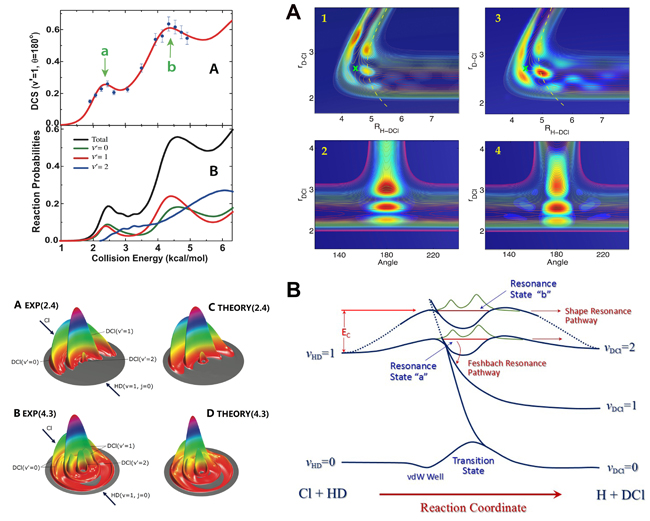Recently, the group with leader of CAS Member Xueming Yang and Professor Donghui Zhang made breakthrough in the molecular reaction dynamics study in Dalian Institute of Chemical Physics. The relevant paper, written by Chunlei Xiao, Zhigang Sun, Donghui Zhang and Xueming Yang, titled as “Extremely short-lived reaction resonances in Cl+HD(v=1)→DCl+H due to chemical bond softening”, was just published in Science Magazine (Jan 2, 2015, Vol.347, Pg 60). This study greatly promotes our understanding in resonance states in a chemical reaction.
In the reaction dynamics field, one of the fundamental tasks is investigation of the role of transition states in controlling the reaction rate constants and determining the product distributions, which naturally makes direct observation of the transition state be a Holy Grail. However, due to extremely short lifetime of the transition state in a direct reaction (about 10-15 second, one femtosecond), it is impossible to directly observe such transition state experimentally with current techniques. The reactive resonance states, which occur around the transition state region and with longer lifetimes, provide a chance to directly observe the behaviors of chemical reactive dynamics around transition state. Thus there has been focused interest for the passed decades insearchingfor resonance states in a chemical reaction. At the same time, the reactive resonance states, which are quasi-bound states from quantum mechanics, can greatly influence the reaction rates and the product distributions. The relevant studies thus can enrich our knowledge on chemical reaction dynamics.

The discovery of the signature of reactive resonances by theoretical studies was reported in 1970s, and in 1984, Lee YT and his co-workers observed obvious forward scattering in the F + H2 reaction by molecular crossing beam apparatus. The forward scattering had been regarded being as the signature of the existence of reactive resonance in a direct reaction, thus the discovery of Lee caused a sensation in those days.
Since 2006, a series of work on the study of chemical resonances in the F + H2/HD reaction have been carried in the group of Yang and Zhang. By using high-resolution molecular crossing beam apparatus, constructing high-quality ab initio potential energy surface, and developing highly efficient quantum reaction dynamics theoretical method, the resonances in the F + H2/HD reaction were investigated in details. A number of relevant papers were published on Science magazine and PNAS journal. They clearly claimed the existence of the resonance in the F + H2/HD reaction, which deepen much our understanding of the chemical reaction.
Along with the development, a question naturally arises: Is chemical resonance really rare and difficult to encounter in chemistry? The answer to this question is far-reaching significance in chemistry.
By using the high-resolution molecular crossing beam apparatus, and recently developed stimulated Raman excitation technique, in the backward scattering of Cl + HD (v=1) →DCl+H reactive scattering, oscillated signals were observed by Chunlei Xiao and Xueming Yang et al. This might implies the existence of chemical resonances. It was surprising since there was no previous study for this reaction from ground state indicating any possible signature of chemical resonances.
In order to explain the oscillation in the backward scattering, Zhigang Sun and Donghui Zhang and their co-workers constructed new accurate potential energy surface, and carried out the corresponding accurate quantum reaction dynamics calculations. The theoretical results suggest that there are indeed reactive resonance states in this reaction, which thus becomes the next prototype for studying chemical resonances after the F + H2 reaction and its isotopes.
The resonances in the Cl + HD (v=1) →DCl+H is different from those Feshbach resonances in the F + H2 reaction and its isotopes, which actually share the characteristics of both Feshbach and shape resonance. These resonances have much shorter lifetimes (about 20fs) than those in the F + H2 reaction and its isotopes (about 100fs), thus hardly resulting in any forward scattering. Around the transition state region, the interaction between H and DCl softens the DCl bond, manifesting not only in smaller vibrational frequency but, more importantly, also in larger anharmonicity. Mainly the latter considerably lowers the DCl energy levels for vibrationally excited states, resulting in a shallow well on the DCl (vDCl= 2)–H vibrational adiabatic potential around the peak position of the ground vibrational adiabatic potential, which supports resonance states. This is contrast withthe ground vibrational adiabatic potential, there is a single barrier located at the product side close to the static barrier of the reaction system.
Chemical bond softening in the transition state region always occurs in reactions with energetic barriers and can result in potential wells on highly excited vibrational adiabatic potentials. The existence of similar resonances in many other chemical reactions involving vibrationally excited reagents can be anticipated. Such as, quantum reactive scattering calculations showed that similar dynamical resonances also exist in the Cl + HD (v = 1) →HCl + D reaction channel. Thus the resonances similar to those in the Cl + HD (v = 1) →DCl + H should be quite general. This is an important discovery and has a profound influence in the chemical reaction dynamics field. This finding is helpful for understanding some related phenomena in combustion, where excited state reactions dominate.
This closely cooperated study between theorists and experimentalists brings about a new mechanism of chemical resonances, which has been pursued for a long time, and opens a door for finding and investigating chemical resonances in the future.